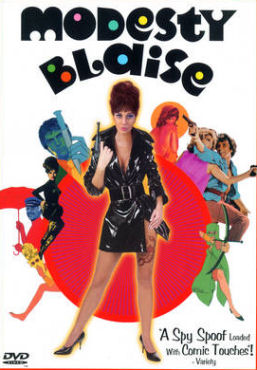
We science fiction and fantasy people are generally an eclectic bunch; by that I mean we don’t just read the stuff, we generally read comics, go to movies, collect stuff related to our interests and so on. And we often don’t limit ourselves to straight sf/fantasy; a very large number of us are also readers of mysteries, detective novels, adventure novels and thrillers. (Not only the readers, but also the writers: an amazing percentage of sf/fantasy writers whom I know personally are great fans of mystery/detective (also called ‘tec) and thriller writers and writing, not only professionally but personally.) Even John D. MacDonald, one of America’s greatest adventure/’tec writers, wrote science fiction (Ballroom of the Skies; Wine of the Dreamers; The Girl, the Gold Watch, and Everything, plus a number of terrific short stories). To me, some of the best and most enjoyable of those kinds of writing also have a strong fantastic component. Two of my favourites are Murphy and Sapir’s The Destroyer, and Peter O’Donnell’s (and Jim Holdaway’s) Modesty Blaise.
We won’t go into The Destroyer much now, but those of you already familiar with the character and/or the series know that Remo Williams/Master of Sinanju Chiun and the organization known as CURE have sold millions of copies of paperbacks and had a Marvel comic magazine as well as a TV pilot and a movie (Remo Williams: The First Adventure) made, despite being almost pure fantasy from beginning to end. But it’s fantasy with a strong action/adventure bent (and a very sardonic sense of humour), and that kept it out of our genre as far as booksellers were concerned. So it ended up next to Tom Clancy and the like on the bookstore shelves. As did the focus of this week’s blog entry, the woman known as Modesty Blaise.
Modesty Blaise is the creation of a comic strip writer named Peter O’Donnell, who had worked on a number of strips before a wartime experience gave him the seed of an idea for his own action strip. He wanted a female action hero that could do all the things that James Bond and the other male action heroes were doing, but he wanted it to be plausible. He remembered that—and if you’ve read any Modesty (either book or strip) you’ll find this very familiar—in 1942 he and some Army colleagues were camped by a stream in in the north of what was then Persia (now Iran), up near the Caucasus Mountains, when a young girl of about 12 showed up at the edge of their campfire, dressed in ragged clothing, with a stick with a nail through it hanging from her neck. She was wary, but not afraid of them, and they managed—through a combination of motioning and talk in a kind of pidgin—to get her to take a couple of cans of food and a can opener. After eating she gave them a smile that “could have lit up a village, and she walked away; she walked like a little princess….” and they never saw her or heard anything about her again.

O’Donnell tried working on his new strip with Dan Dare artist Frank Hampton, but was dissatisfied with the results; he ended up partnering with Jim Holdaway. The new strip debuted in 1962; this partnership lasted until Holdaway’s death in 1970, and the strip continued until 2002 with various artists; however, many people still think of (and prefer) Holdaway as “the” Modesty Blaise artist. In 1963, the first Modesty Blaise book was published, titled Modesty Blaise—what else? It was followed by a ‘60s-style “pop” movie starring Italian actress Monica Vitti as Modesty, Terence Stamp as her friend and “sidekick” Willie Garvin, and Dirk Bogarde as the villain Gabriel. The movie more or less followed the storyline of the book, but was pretty lame—for one thing, Willie and Modesty were lovers in this movie, which would never happen in the books or strips.
The salient facts on Modesty are these: a young girl, age unspecified but about 10 years old, in 1945 found herself in a DP camp (displaced persons) in Greece, along with an elderly Jewish scholar named Lob whom she had met in her wanderings through the post-war Middle East, North Africa and Mediterranean areas; she knew nothing of her past or her parents, and had survived the war on her own, learning to survive any way she could. Lob became her friend and tutor, teaching her reading and writing in several languages, plus anything else she might need to survive. He named her Modesty; she chose the last name Blaise, from Merlin’s tutor in the Arthurian legends. After several years Lob died when she was still a pre-teen; Modesty continued wandering and surviving—at one point she was adopted by an Arab tribe—until she became part of the Louche gang in Tangiers, finally taking over the gang when Louche died, renaming it The Network. The Network dealt in criminal matters—never touching drugs or slavery, because Modesty (called “mam’selle” by her underlings) was against them.

During the post-Louche years she met Willie Garvin, adventurer and thief, but she saw his potential and offered him a job. He became her right-hand man in The Network, also becoming Modesty’s dearest and most-trusted friend. They maintained a strictly Platonic relationship, fearing that any sexual element might destroy what they had between them. He was the only man who is allowed to call her “Princess” (save the Arabs, who called her “el sayyid,” which means the same). After they retired from criminal work and turn The Network over to one of Modesty’s underlings, they moved to London; Modesty attained British citizenship some time before from a “marriage of convenience.” With plenty of money—Modesty bought a penthouse apartment in Mayfair; Willie fulfilled a lifelong dream and bought a pub (“The Treadmill”)—they soon got bored with their sedentary lifestyle and began a relationship with Sir Gerald Tarrant of the British Secret Service, which brought all kinds of adventure into their lives, much of it involving oddball and unlikely villains.
Those are the bare facts; it would take pages and pages to describe the strips, the books and the movies—two of which have been made so far (and a TV pilot set in Los Angeles; it was forgettable at best)—the aforementioned Monica Vitti thing and a more recent (2002) film starring Alexandra Staden as Modesty, and set in the Louche casino in Tangiers—no Willie Garvin in this movie. It’s a better movie—Staden is a better actress than Vitti, who could speak no english when she made her movie, and had to learn her dialogue phonetically—but still not satisfying, partially because neither actress resembles Blaise physically. She is described as “Eurasian,” and Jim Holdaway’s Modesty (see Photo 1) is what most people think of when they think of her. As you can see from the Featured Image, Monica Vitti was made up to resemble Holdaway’s Blaise; but neither has the acrobatic body or personality given us by the books and strips.

I confess, though, that I am not as big a fan of the strips as I am of the books. There are twelve novels and a thirteenth collection of short stories. I started reading Modesty in the mid-1960s after seeing the movie while I was in the US Navy, and didn’t see the strips until nearly twenty years later. Since Peter O’Donnell died in 2010 at the age of ninety, and he purposely killed both Blaise and Garvin in the last book he wrote—Cobra Trap (1996)—any new adventures will have to take place, according to O’Donnell, before that last book. This was O’Donnell’s attempt to keep the series from continuing under other, possibly worse, writers. (Some Modesty fans refuse to read that book, arguing that if they don’t read it, Modesty and Willie can’t die.)
Another big fan of the books is Quentin Tarantino, who allowed the Staden movie to be released under the “Quentin Tarantino Presents” label, although he had little or nothing to do with it; if you saw the movie Pulp Fiction, you will remember the scene where John Travolta was reading the American hardcover (Photo 4) in the toilet while waiting for Bruce Willis. Tarantino has said he wants to make a Modesty Blaise movie for years—even Diana Rigg wanted to star in a Modesty Blaise movie, but that too never came to fruition—but after the Monica Vitti movie O’Donnell bought up the film rights and steadfastly refused to let another one be made; he said he saw screenplays by ten or eleven experienced writers, and said none of them captured the characters correctly.
As with John D. MacDonald’s characters Travis McGee and Meyer, one gets to know Modesty Blaise, Willie Garvin, Sir Gerald Tarrant, Willie’s sometime lover Lady Janet Gillam, Weng the “houseboy” and other continuing characters, and to like and admire them. They are all increasingly well rounded from book to book; even lesser characters like Stephen Collier and his blind wife Dinah, who uses ESP to find things out. (And as I write this, I’m getting some kind of déja vu that says I’ve seen the scene where Willie rescues Dinah in some kind of movie, though I can’t find that anywhere on a Google search. I wonder what my brain is telling me? I urge you all—get in touch with your brains; sometimes it comes in useful!)
Why does Modesty Blaise fit in the sf/fantasy category, you ask? Well, for one thing, Modesty’s talents (not to mention Willie’s) are somewhat superhuman—I defy you to show me a real person who’s as competent at so many things as she/they are; they are also nearly telepathic in how well they mesh during a caper. For another many of the villains use psychic powers (much like Willie’s squeeze, Lady Janet)—“Lucifer,” in I, Lucifer, has the psychic talent of knowing, from nearly any distance, who in a given list of people is going to die soon. Maybe the elements aren’t as fantastic as in, say The Destroyer, where a practitioner of Sinanju (the “sun source” of all martial arts) can do anything, including running over water, falling from an airplane without a parachute, breaking a tank with his bare hands, etc., but the fantastic is never out of reach. From a very early age, I have liked books that had that fantastic element to them, leading me to read some very odd books. Fortunately, I don’t call these two series odd.

Another thing I like about Modesty Blaise the character, besides her remarkable abilities, is the fact that she’s a well-rounded, very human character; she has sexual relations, but only on her terms and with men she both likes and respects. She’s not a bed-hopper like James Bond, but she’s not celibate either—she enjoys sex. But, as mentioned, never ever ever with Willie Garvin, which is just one of the things the first movie got wrong. (She is also not above using the male-female thing as a weapon: one of the tricks she uses when entering a roomful of heavily-armed male opponents is to strip to the waist—she calls it “The Nailer”—to distract them for those few crucial moments needed to gain the upper hand.) I should ask some female fans if Modesty’s character is attractive to them as well, or if things like “The Nailer” are offensive.
I should also mention that Modesty’s adventures have been dramatized on BBC radio; there are three I know of. In 1978, Last Day in Limbo was produced as an audio drama; in the 1980s, Peter O’Donnell wrote a radio short story called “I Had a Date With Lady Janet,” which was good, but reminiscent of one or more of the books (I’d have to listen again to pin it down); and in 2012 the book A Taste For Death was produced in 15-minute segments.
All the books and movies are available from your favourite online retailer; but I suggest you try your local brick-and-mortar store first for the books—very few places carry older movies, unless you get lucky in a “bargain bin.” I know I’ve looked in places like Future Shop and Wal-Mart (yes, bad me, I know) for these, but had to settle for buying the movies online. I won’t mention any online retailers, as I have no intention of playing favourites. The books are (in order): 1965 – Modesty Blaise; 1966 – Sabre-Tooth; 1967 – I, Lucifer; 1969 – A Taste for Death; 1971 – The Impossible Virgin; 1972 – Pieces of Modesty (short stories); 1973 – The Silver Mistress; 1976 – Last Days in Limbo; 1978 – Dragon’s Claw; 1981 – The Xanadu Talisman; 1982 – The Night of Morningstar; 1985 – Dead Man’s Handle; 1996 – Cobra Trap. Some are better than others, but I have to say that I enjoy them enough to reread often. I was fortunate enough to get an autographed copy of Cobra Trap. I have some of the others in hard cover, but most in British (Pan) editions.
As stated, I’m not a giant fan of the strips, but you can find them online as well for purchase, both collected in book form, or as singles, I think. Probably—since the books and strips do not generally share storylines—I will end up buying all the collections just to have new Modesty to read. She’s addictive that way!
I await your comments, pro or con—don’t be afraid to argue with me. Everything I say with the exception of hard facts is my opinion only. But should you want to comment, you can comment on Facebook; I post links in several fannish groups—or if you want to post them here you can register—if you haven’t already—and comment on the Amazing Stories website. Next week more fannish stuff. Oh, and here’s my wrapup on NaNoWriMoVember: I got one (1) pledge—thanks, Gregg—and managed to get four or five chapters written on a new book; it will take me a couple more months to finish it. Because it’s set in 1911, I’m doing a ton of research; every time I learn something new I have to incorporate it. Google 1911 yourself—it’s a fascinating year! See you next week!











Recent Comments